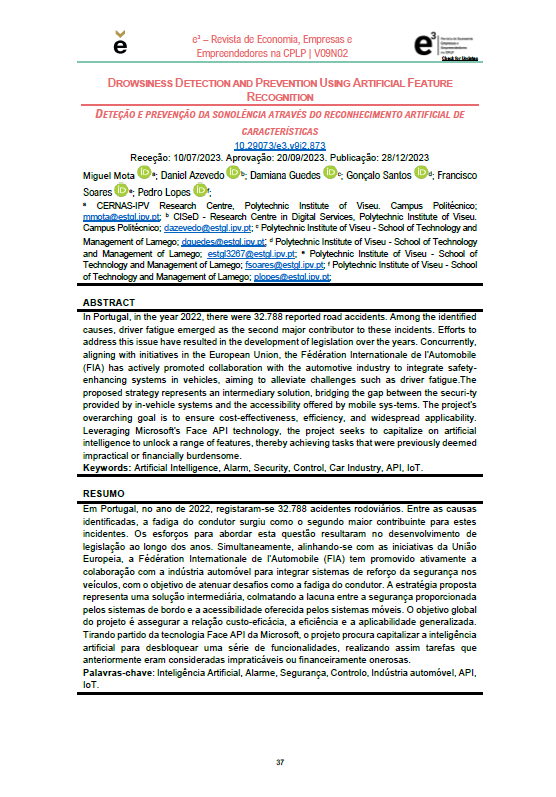DROWSINESS DETECTION AND PREVENTION USING ARTIFICIAL FEATURE RECOGNITION
Main Article Content
Abstract
In Portugal, in the year 2022, there were 32.788 reported road accidents. Among the identified causes, driver fatigue emerged as the second major contributor to these incidents. Efforts to address this issue have resulted in the development of legislation over the years. Concurrently, aligning with initiatives in the European Union, the Fédération Internationale de l'Automobile (FIA) has actively promoted collaboration with the automotive industry to integrate safety-enhancing systems in vehicles, aiming to alleviate challenges such as driver fatigue.
The proposed strategy represents an intermediary solution, bridging the gap between the security provided by in-vehicle systems and the accessibility offered by mobile systems. The project's overarching goal is to ensure cost-effectiveness, efficiency, and widespread applicability. Leveraging Microsoft's Face API technology, the project seeks to capitalize on artificial intelligence to unlock a range of features, thereby achieving tasks that were previously deemed impractical or financially burdensome.
Downloads
Article Details

This work is licensed under a Creative Commons Attribution 4.0 International License.
References
AforgeTeam. (2019). AForge.NET: Computer Vision, Artificial Intelligence, Robotics. Retrieved April 19, 2023, from http://www.aforgenet.com/framework/
ANSR/MAI, P. (2018). Acidentes de viação com vítimas, feridos e mortos - Continente. PorData. Retrieved April 19, 2023, from https://www.pordata.pt/Portugal/Acidentes+de+via%c3%a7%c3%a3o+com+v%c3%adtimas++feridos+e+mortos+++Continente-326-3587
Ataei, M., Esmaeilpour, A., & Yousefi, M. R. (2019). Driver drowsiness detection using facial landmark estimation and eye aspect ratio. Measurement, 139, 373-381.
Azati (2019) reports on the cost of artificial intelligence (AI) in 2019. Retrieved from https://azati.ai/how-much-does-it-cost-to-utilize-machine-learning-artificial-intelligence/
Bizdirect. (2019). Quem somos. Retrieved April 19, 2023, from https://www.bizdirect.pt/pt/quem-somos
C# DESIGN GOALS. (2011, January 23). Retrieved April 19, 2023, from https://feeldotneteasy.blogspot.com/2011/01/c-design-goals.html
Choi, Y., Jeong, J., & Lee, J. (2021). Driver drowsiness detection using facial land-marks, head movement, and bio-signal features with deep learning. IEEE Transactions on Intelligent Transportation Systems. https://doi.org/10.1109/TITS.2021.3119049
Dlib.net. DLIB C++ Library. http://dlib.net/
Guru99. (2019). What is Soak Testing? Definition, Meaning, Examples. Available at: https://www.guru99.com/soak-testing.html [Accessed: April 19, 2023].
Hall-Geisler, K. (2019). How Anti-sleep Alarms Work. Available at: https://electronics.howstuffworks.com/gadgets/automotive/anti-sleep-alarm.htm [Ac-cessed: April 19, 2023].
IDEOU. (2019, August 4). Design Thinking. IDEO U. https://www.ideou.com/pages/design-thinking
Jafari, S. A., Zanjanizadeh Ezazi, M. P., Torkamani, M. J., & Rahimpour, A. (2021). An overview of deep learning in medical imaging: Focus on MRI. Journal of Medical Signals and Sensors, 11(3), 137-151.
Kim, H., Yoo, J., & Han, J. (2021). A Comparative Study on Driver Drowsiness Detec-tion Systems based on Facial Landmark Estimation and Machine Learning Techniques. Sensors, 21(11), 3875.
Kim, M., Lee, W., & Choi, S. (2020). Real-Time Driver Drowsiness Detection System based on Facial Features using Convolutional Neural Network. Journal of Advanced Transportation, 2020. doi: 10.1155/2020/8827386.
Lee, H., Lee, S., & Lee, S. (2022). Driver Drowsiness Detection System Based on Facial Landmarks and Artificial Neural Network. Sensors, 22(3), 957.
Liu, Y., Wang, Z., Lv, Z., & Sun, J. (2017). Driver Drowsiness Detection using Dynam-ic Facial Analysis. IEEE Transactions on Intelligent Transportation Systems, 18(4), 945-954.
Mercedes-Benz. (2019, August 4). Safety. Mercedes-Benz USA. https://www.mbusa.com/mercedes/benz/safety#module-3
Microsoft. (2019, August 11). Azure Cognitive Services. Microsoft Azure. https://azure.microsoft.com/en-us/support/legal/cognitive-services-compliance-and-privacy/
Microsoft. (2019, August 11). Windows Presentation Foundation. Microsoft. https://docs.microsoft.com/en-us/dotnet/framework/wpf/
Microsoft. (2019, August 13). IntelliSense. Microsoft. https://code.visualstudio.com/docs/editor/intellisense
Microsoft. (2019, August 13). SQL Server. Microsoft. https://www.microsoft.com/en-us/sql-server/sql-server-2017
Microsoft. (2019, August 13). The History of C#. Microsoft. https://docs.microsoft.com/en-us/dotnet/csharp/whats-new/csharp-version-history
Microsoft. (2019, August 13). Visual Studio. Microsoft. https://visualstudio.microsoft.com/vs/
Microsoft. (2019, August 4). Face Detection and Attributes. Microsoft Azure. https://docs.microsoft.com/en-us/azure/cognitive-services/face/concepts/face-detection
Microsoft. (2019, June 25). Face API - Facial Recognition Software | Microsoft Azure. Microsoft Azure. https://azure.microsoft.com/en-us/services/cognitive-services/face/
Oppel, A. (2004). Databases Demystified. McGraw-Hill Osborne Media.
Oracle. (2019, August 13). History of SQL. Oracle. https://docs.oracle.com/cd/B12037_01/server.101/b10759/intro001.htm
Ozkan, M. & Turk, M. (2017). Driver drowsiness detection based on shape and texture analysis of facial images. Image and Vision Computing, 57, 38-46.
Plattner, H., Meinel, C., & Leifer, L. J. (2011). Design thinking: Understand, improve, apply. Berlin: Heidelberg.
PORDATA. (2022). Acidentes de viação com vítimas - Total e por tipo de acidente. PORDATA - Base de Dados de Portugal Contemporâneo. https://www.pordata.pt/
RoSPA. (2019, August 11). Driver Fatigue and Road Accidents - a Literature Review and Position Paper. Road Safety Knowledge Centre. http://www.roadsafetyknowledgecentre.org.uk/knowledge/545.html
Santos, G., Lopes, P., Guedes, D., Azevedo, D., & Soares, F. (2023). Drowziness pre-vention system based on artificial intelligence facial features detection. Special Issue - ICE2MAS, 92-99.
Singh, P., Bajaj, P., & Gupta, S. (2017). A Vision-Based System for Driver Drowsiness Detection using Pupil Detection and Mouth Detection. In 2017 International Conference on Computing, Communication and Automation (ICCCA) (pp. 935-940). IEEE.
Sun, H. F., Park, S. S., & Cho, S. H. (2018). Facial landmarks-based driver drowsiness detection using deep neural networks. Neural Computing and Applications, 30(10), 3177-3186.
TECH, T. (2019, August 5). Nap Zapper. TBO TECH. https://www.tbotech.com/napzapper.htm
Volvo. (2019, August 4). Driver Alert Control. YouTube. https://www.youtube.com/watch?v=sVDTnFeutOs
Zaidi, B., Ilyas, M. U., & Imran, A. (2020). Driver Drowsiness Detection Based on Fa-cial Features using Machine Learning Techniques. International Journal of Advanced Computer Science and Applications, 11(7), 87-93.





